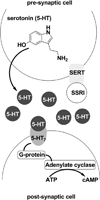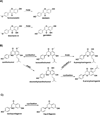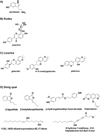Botanical modulation of menopausal symptoms: mechanisms of action?
- PMID: 23408273
- PMCID: PMC3800090
- DOI: 10.1055/s-0032-1328187
Botanical modulation of menopausal symptoms: mechanisms of action?
Abstract
Menopausal women suffer from a variety of symptoms, including hot flashes and night sweats, which can affect quality of life. Although it has been the treatment of choice for relieving these symptoms, hormone therapy has been associated with increased breast cancer risk leading many women to search for natural, efficacious, and safe alternatives such as botanical supplements. Data from clinical trials suggesting that botanicals have efficacy for menopausal symptom relief have been controversial, and several mechanisms of action have been proposed including estrogenic, progestogenic, and serotonergic pathways. Plant extracts with potential estrogenic activities include soy, red clover, kudzu, hops, licorice, rhubarb, yam, and chasteberry. Botanicals with reported progestogenic activities are red clover, hops, yam, and chasteberry. Serotonergic mechanisms have also been proposed since women taking antidepressants often report a reduction in hot flashes and night sweats. Black cohosh, kudzu, kava, licorice, and dong quai all either have reported 5-hydroxytryptamine receptor 7 ligands or inhibit serotonin reuptake, therefore have potential serotonergic activities. Understanding the mechanisms of action of these natural remedies used for women's health could lead to more efficacious formulations and to the isolation of active components which have the potential of becoming effective medications in the future.
Georg Thieme Verlag KG Stuttgart · New York.
Conflict of interest statement
The authors have no conflict of interest regarding the materials discussed in the manuscript.
Figures








Similar articles
-
Botanicals and Their Bioactive Phytochemicals for Women's Health.Pharmacol Rev. 2016 Oct;68(4):1026-1073. doi: 10.1124/pr.115.010843. Pharmacol Rev. 2016. PMID: 27677719 Free PMC article. Review.
-
Non-estrogen conventional and phytochemical treatments for vasomotor symptoms: what needs to be known for practice.Climacteric. 2012 Apr;15(2):115-24. doi: 10.3109/13697137.2011.624214. Epub 2011 Dec 8. Climacteric. 2012. PMID: 22148909 Review.
-
Botanical and dietary supplements for menopausal symptoms: what works, what does not.J Womens Health (Larchmt). 2005 Sep;14(7):634-49. doi: 10.1089/jwh.2005.14.634. J Womens Health (Larchmt). 2005. PMID: 16181020 Free PMC article. Review.
-
Nonhormonal therapies for hot flashes in menopause.Am Fam Physician. 2006 Feb 1;73(3):457-64. Am Fam Physician. 2006. PMID: 16477892 Review.
-
Protocol for systematic review and meta-analysis: hop (Humulus lupulus L.) for menopausal vasomotor symptoms.BMJ Open. 2016 Apr 22;6(4):e010734. doi: 10.1136/bmjopen-2015-010734. BMJ Open. 2016. PMID: 27105715 Free PMC article.
Cited by
-
Quality evaluation of health foods containing licorice in the Japanese Market.Toxicol Rep. 2019 Aug 21;6:904-913. doi: 10.1016/j.toxrep.2019.08.013. eCollection 2019. Toxicol Rep. 2019. PMID: 31508319 Free PMC article.
-
Formation and biological targets of botanical o-quinones.Food Chem Toxicol. 2018 Oct;120:700-707. doi: 10.1016/j.fct.2018.07.050. Epub 2018 Jul 29. Food Chem Toxicol. 2018. PMID: 30063944 Free PMC article. Review.
-
In the Search for Novel, Isoflavone-Rich Functional Foods-Comparative Studies of Four Clover Species Sprouts and Their Chemopreventive Potential for Breast and Prostate Cancer.Pharmaceuticals (Basel). 2022 Jun 28;15(7):806. doi: 10.3390/ph15070806. Pharmaceuticals (Basel). 2022. PMID: 35890104 Free PMC article.
-
Breast cancer prevention with liquiritigenin from licorice through the inhibition of aromatase and protein biosynthesis in high-risk women's breast tissue.Sci Rep. 2023 May 30;13(1):8734. doi: 10.1038/s41598-023-34762-z. Sci Rep. 2023. PMID: 37253812 Free PMC article.
-
Botanicals and Their Bioactive Phytochemicals for Women's Health.Pharmacol Rev. 2016 Oct;68(4):1026-1073. doi: 10.1124/pr.115.010843. Pharmacol Rev. 2016. PMID: 27677719 Free PMC article. Review.
References
-
- Roush K. Managing menopausal symptoms. Am J Nurs. 2012;112:28–35. - PubMed
-
- Rossouw JE, Anderson GL, Prentice RL, LaCroix AZ, Kooperberg C, Stefanick ML, Jackson RD, Beresford SA, Howard BV, Johnson KC, Kotchen JM, Ockene J. Risks and benefits of estrogen plus progestin in healthy postmenopausal women: principal results from the Women's Health Initiative randomized controlled trial. JAMA. 2002;288:321–333. - PubMed
Publication types
MeSH terms
Substances
Grants and funding
LinkOut - more resources
Full Text Sources
Other Literature Sources
Medical

